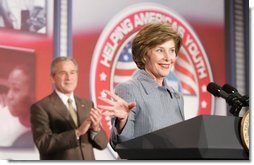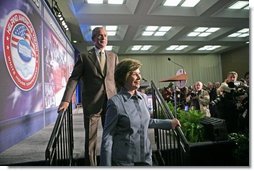
- Afghanistan
- Africa
- Budget Management
- Defense
- Economy
- Education
- Energy
- Environment
- Global Diplomacy
- Health Care
- Homeland Security
- Immigration
- International Trade
- Iraq
- Judicial Nominations
- Middle East
- National Security
- Veterans
|
Home >
News & Policies >
October 2005
|
For Immediate Release
Office of the Press Secretary
October 27, 2005
President and Mrs. Bush Discuss Helping America's Youth at White House Conference
Howard University
Washington, D.C.
![]() Fact Sheet: A Commitment to Helping America's Youth
Fact Sheet: A Commitment to Helping America's Youth
![]() Helping America's Youth
Helping America's Youth
9:35 A.M. EDT
THE PRESIDENT: Thank you all. Thanks for the warm welcome to Laura. Please be seated. Thank you. I am the introducer -- (laughter) -- a rare role for me these days, but one I've been looking forward to.
First of all, thank you all for coming. I want to thank Howard University for hosting this important summit. I love to be with the armies of compassion. (Applause.) At my State of the Union last year, I asked Laura to lead an initiative to help young people grow up to be successful adults. And since that State of the Union, she has taken me up on my request, and she has traveled the country to observe and find best practices and programs that are changing people's lives for the better.
 And so she called this summit to serve as a catalyst to continue to rally
decent, honorable people who are working hard to make sure young Americans
have a chance to realize the promise of this country. She is a great
leader of this cause, a wonderful wife, and a wonderful First Lady for our
country.
And so she called this summit to serve as a catalyst to continue to rally
decent, honorable people who are working hard to make sure young Americans
have a chance to realize the promise of this country. She is a great
leader of this cause, a wonderful wife, and a wonderful First Lady for our
country.
Laura Bush. (Applause.)
MRS. BUSH: Thank you, Mr. President. Thank you all. Thank you so much. Thank you all. Please be seated.
Thank you. I've been so looking forward to this day. I'm so excited about everything we're going to hear and each one of our participants who agreed to share their expertise and their knowledge with us. I've met many of the people who are speaking today as I've traveled around the country, and I know what a wealth of knowledge and compassion they bring to all of us. And so I want to thank each one of them for being here.
Today's Conference on Helping America's Youth is about helping all young people -- boys and girls, children and teens -- grow up to be healthy and successful adults. I'm honored that my husband asked me to lead this initiative, which has given me the opportunity to meet so many terrific young people, as well as the caring adults who have made it their life commitment to help the young people around them grow up.
Thanks to all of you for being here at Howard University, and especially thanks to Dr. Patrick Swygert, to Renee Higginbotham-Brooks and the entire Howard community, who are wonderful hosts. (Applause.)
I want to acknowledge the many people who are joining us on the Internet today and at college campuses across America. Thanks to the Cabinet Secretaries and spouses, members of Congress and governors' spouses who are here. I'm grateful to the many people in the departments and agencies of the federal government who worked so hard to organize this conference. And I'm especially grateful to the members of my staff, who have worked around the clock to bring this conference to you. (Applause.)
This morning we'll hear from researchers who are identifying the challenges that children face and helping to craft the solutions to those challenges. This afternoon we'll meet some of the people that I've met in my travels around our country and other men and women who are involved in efforts to help youth.
 We all know that mothers and fathers are the most important influences in a
child's life. Children whose parents show them love and support and stay
active in their lives have an enormous advantage growing up. Yet too many
children grow up in homes where one parent is absent, most often their
father. Young people who grow up without their dads suffer a profound
loss. And as I've traveled, I've been encouraged to meet so many young men
who have suffered this loss, and, because of it, have resolved to be a good
father to their own children. Some of these young fathers are with us
today.
We all know that mothers and fathers are the most important influences in a
child's life. Children whose parents show them love and support and stay
active in their lives have an enormous advantage growing up. Yet too many
children grow up in homes where one parent is absent, most often their
father. Young people who grow up without their dads suffer a profound
loss. And as I've traveled, I've been encouraged to meet so many young men
who have suffered this loss, and, because of it, have resolved to be a good
father to their own children. Some of these young fathers are with us
today.
Being a good dad doesn't always come naturally. Young men who become fathers need help in learning how to stay involved in their children's lives. The National Center for Fathering, in Kansas City, helps fathers develop emotional bonds with their children. When a father reads with his son or daughter, or makes time for a hug, or just talks about his child's day, his child feels like the most important person in the world. And that feeling of love never goes away.
Children need to be surrounded by caring adults in every part of their lives. Grandparents, teachers, mentors, pastors, and coaches can support parents and help children make better choices that lead to a healthier and more satisfying life.
Outside of family, school is the next most important part of a child's life, and education is vital to helping America's youth. Today we'll hear about programs that are engaging children in their studies and preparing them for success beyond high school.
Dr. Shep Kellam believes that children need to be taught how to be good students; that it's not just intuitive. Dr. Kellam and his research partners devised the Good Behavior Game for 1st- graders in Baltimore. The Good Behavior Game is a simple and effective program that school districts can adopt for their own 1st-graders. Dr. Kellam's research shows that 86 percent of high-risk students who were taught the Good Behavior Game in the 1st grade graduated from high school, compared to just 19 percent of their peers.
In Atlanta, the Computer Assisted Debate program -- called CAD -- brings college debate champions into middle schools to coach students in debate. The middle school students learn to use their voice and their intellect to express themselves, and to settle differences with words rather than fighting or through violence. One of these debate coaches told me that he uses words from the SAT as "CAD power words" so that students can start preparing for college even in middle school. And students win debate competitions and medals, achievements they can put on their resumes to improve their chances of being accepted by the college of their choice.
A child's community is the third major part of her life. Father Gregory Boyle, who we'll hear from today, helps young people in East L.A. who want to leave gangs and develop job skills. Father Boyle puts young people to work at Homeboy Industries, silk-screening t-shirts or working at Homegirl Caf and Bakery. The young people I spoke to at Homeboy Industries said that Father Boyle would literally ride his bike through a gang fight to stop it. With the skills they learn at Homeboy, young men and women can find a job that offers stability and security.
Will Power to Youth is a program run by the Shakespeare Festival of Los Angeles. Will Power employs teenagers to produce Shakespeare's plays, and it's not just a program for budding actors and actresses. Will Power teaches young people how to work lights and sound and build stages. I met Jesus, a young man who was on the scenic design team for a production of Romeo and Juliet. After learning skills at Will Power, Jesus applied for a job at the Home Depot Design Center -- and he got the job. He's been training on Home Depot's software and he works in the store, providing advice to customers redoing their kitchens. His next goal is to enroll at East L.A. Community College.
Youth in every community face challenges, and successful programs like Will Power can be adapted or adopted all over the country to meet a variety of needs.
Starting today, communities across America can access the Community Guide to Helping America's Youth. The Guide was developed by several federal agencies and it's available online at www.HelpingAmericasYouth.gov. Communities can use the Guide to assess the resources they already have and then to identify their gaps in services for their young people, and then find programs and resources to fill those gaps.
Many promising programs still need to be studied so we can determine their effectiveness. Research done by think-tanks, universities, social scientists, and others can identify effective programs and help individuals, private organizations and governments that want to improve life for children in their communities
The time between childhood and adulthood is all too short -- as George and I can attest -- and every moment in a child's life is precious. At Think Detroit, a program that teaches character development and healthy behavior through sports, a newspaper reporter asked one of the little boys I met what he thought about my visit. And I was moved when I read that he simply said, "I wish she could stay here."
Children want us in their lives, and they need us in their lives. And as I've learned from the remarkable men and women I've met across our country, each of us has the power to bring hope and opportunity to children's lives.
Thank you all very, very much for your wonderful work. Thanks for being here today. We'll be educated and enlightened by our wonderful speakers, and I want to thank them again for bringing their expertise to today's conference.
As you go home tonight and tomorrow, I urge you to use the online Assessment Tool, and contact teachers, clergy, law enforcement, all the members of your community to work together to help America's youth. Thank you all very, very much.
END 9:47 A.M. EDT


